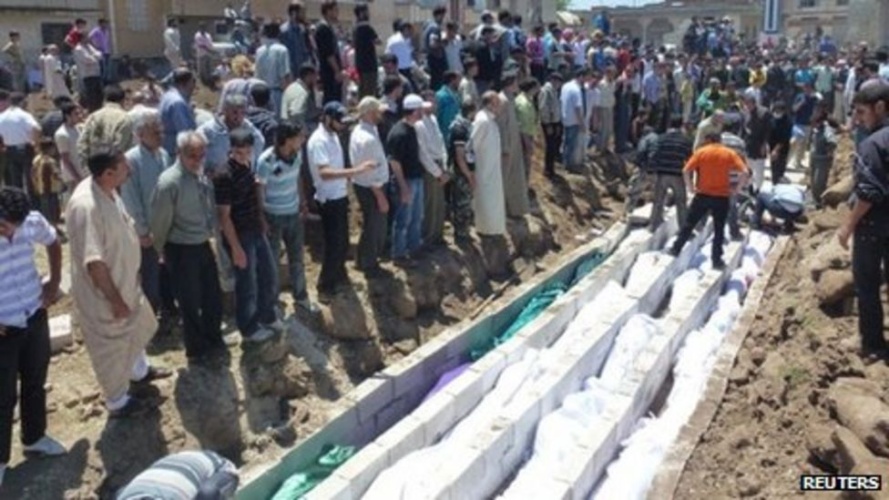The 108 victims of a mass killing by Assad regime forces are buried in Houla, June 2012
A new report, by the war crimes investigators of the Commission for International Justice and Accountability, documents how the highest levels of Syria’s Assad regime “planned, organised, instigated and deployed” paramilitary units to crush a nationwide uprising from March 2011.
UN investigators in 2012 found reasonable grounds to believe that the paramilitary enforcers, “shabiha”, against humanity. They included murder, torture, arbitrary arrest and detention, sexual violence, and pillaging.
Seven regime documents are published in full in the report. CIJA quotes from others which cannot yet be posted in full, as they are part of ongoing investigations in European countries.
As early as January 2011, concerned about protests in Syria’s largest city Aleppo, the regime was considering the creation of “Popular Committees”. These would integrate shabiha into the security forces, training, instructing, and arming them.
The approach would distance Bashar al-Assad and his officials from any abuses and war crimes. “The regime did not want the security forces and army to be pictured doing these things,” explains Fadel Abdul Ghany, chair of the Syrian Network for Human Rights.
Read the Full Report
On March 2, about two weeks before the initial protests in Daraa in southern Syria, military intelligence instructed local authorities to “mobilize” informers, grassroots organisations. and “friends” of the regime. In April, orders were sent to form the groups into Popular Committees.
Other documents found by CIJA detail instrictions in the spring and summer to the Popular Committees from the regime’s Central Crisis Management Committee — composed of security forces, intelligence agencies, and top officials — which was established by Assad and reported directly to him.
One of the CCMC’s first directives on April 18 ordered the Popular Committees to be trained on the use of weapons against demonstrators and on methods to arrest them and hand them to regime forces.
Throughout 2012, Assad’s military and security agencies were unable to break the protests. So in 2013, the paramilitaries were brought into the National Defense Forces, a 50,000-strong militia whose development was overseen by Iranian military personnel.
The Mass Killings of Civilians
CIJA identifies nine mass killings of civilians as the shabiha carried out the regime’s orders.
They include murders in the Karm al-Zeytoun neighborhood in the city of Homs in March 2012. A local man — withholding his name as his relatives live in regime-held areas in Syria — told Reuters that his wife and five children were among those slain.
“The shabiha put them up against the wall, tried to violate them, then shot them,” he said from opposition territory in northwest Syria.
The man was a member of a rebel faction and was in a nearby district, al-Adawiya, where another mass killing had been carried out by Assad’s paramilitaries.
The moment I heard that my kids were dead, I was holding a six-month-old baby that had just been killed in Adawiya. So, I was imagining what had happened to my kids.
In May 2002, in Houla in western Homs Provice, the shabiha killed 108 civilians, including 34 women and 49 children. Sixty member of the Abdulrazzaq family were murdered.
The following month, 78 people including women and children were shot, hacked, and burnt to death in Mazraat al-Qubair in Hama Province. On May 2-3, 2013, on the streets of Beida and Baniyas in Tartous Province in western Syria, more than 300 civilians — including 58 women and 65 children — were slain.
The mass killings caused tension between some branches of the security forces and some Popular Committees. However, the security forces did not try to check the militias. Instead, they issued instructions to not oppose them.
No shabiha member has just been tried for war crimes. CIJA hopes that the presentation of the evidence will lead to cases being brought.
The Assad regime and its essential enablers such as Russia have prevented an international war crimes court with jurisdiction over Syria. However, countries such as the Netherlands, Sweden, France and Germany have “universal jurisdiction” laws allowing them to prosecute war crimes even if they are committed elsewhere.
The Syrian Network for Human Rights’ explains:
These documents make it possible to pursue people legally — if there are individuals in European countries, then a case can be brought against them. Here you have the paper trail that shows how these units were mobilized.
Overcoming Russia and Assad’s Obstruction
Russia and the Assad regime, using supportive activists in the West, tried to block the CIJA investigation by spreading disinformation about the organization and its leadership.
The campaign included a group of pro-Assad academics and conspiracy theories, styling themselves as the Working Group on Syria, Propaganda and Media. Having devoted itself to disinformation covering up the Assad regime’s chemical weapons attacks, the WGSPM was fed material to assail CIJA.
However, the Russian operation collapsed when one of the WGSPM’s members, mathematician Paul McKeigue, was caught e-mailing “Ivan”, whom he thought was a Russian intelligence operative. Their correspondence exposed the collaboration between Moscow’s officials and the WGSPM, with McKeigue setting out a hit list of war crimes investigators, journalists, academics, and activists to be assailed on social media.
“Ivan” was, in a fact, a CIJA staffer. The sting effectively shut down not only the campaign against the investigators but all of the WGSPM’s activities.
See also From Bosnia to Syria: Disinformation and Its Perpetrators


Assad crimes against humanity are more than to be counted
Unfortunately he seems to be enjoying a protection from Russia
Some locals also say he is enjoying protection from US especially after Obama withdrew his chemical weapons red line and gave Russia and Putin a plain check to do whatever they want to support him